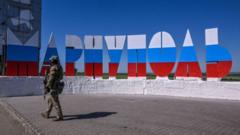Is Mariupol Really 'Diseased'? Residents Challenge Russia's Claims About Their City

Understanding Life in Occupied Mariupol: A Glimpse into the Reality of Residents
Mariupol, a city that became a focal point during Russia's full-scale invasion of Ukraine, has transformed into a symbol of resilience amidst devastation. While Russian authorities paint an optimistic picture of recovery, the lived experiences of its residents tell a different story. This article delves into the harsh realities faced by those still in Mariupol, exploring the ongoing struggles with basic necessities, the impact of propaganda on education, and the quiet resistance against occupation.
The Aftermath of Occupation: A City in Ruins
Since its capture in May 2022, Mariupol has experienced unimaginable destruction. Reports indicate that about 90% of residential buildings have been damaged or destroyed, leaving countless families to navigate life amidst chaos. John, a pseudonym for a local resident, shares, “What they're showing on Russian TV are fairy tales for fools. Most of Mariupol still lies in ruins.”
While Russian media showcase repaired facades along main streets, the reality is starkly different. Residents describe a city filled with rubble, where many still inhabit half-destroyed apartments. The illusion of recovery is merely a façade, designed to project normalcy to the outside world.
Destruction and Displacement
As the conflict raged on, thousands lost their lives, and many more were displaced. The UN estimates that the humanitarian crisis stemming from the siege has left deep scars on the community. The pain of loss, both physical and emotional, lingers heavily in the air.
Basic Necessities: Water, Power, and Food Scarcity
One of the most pressing issues facing residents is the scarcity of clean water. According to residents, water supply is inconsistent, with long stretches of dry days alternating with brief periods of flow. James, another resident, describes the water quality as alarming: “The colour of the water is so yellow that even after boiling it, it's scary to drink it.”
The Water Crisis
- Inconsistent Supply: Water flows intermittently, leaving residents to store buckets and cans during brief supply periods.
- Poor Quality: Many describe the water as resembling cola, raising concerns about health risks.
- Source of Supply: The Siverskyi Donets–Donbas Canal, previously a major water source, was severely damaged, leaving only one reservoir for the city’s needs.
In addition to water shortages, residents grapple with frequent power cuts and soaring food prices. Basic medications have become scarce, posing significant challenges for individuals with chronic health conditions. “Basic medicines are not available. Diabetics struggle to get insulin on time, and it is crazy expensive,” shares James, highlighting the dire situation faced by many.
Education Under Occupation: A Tool for Propaganda
The impact of the occupation extends beyond physical survival; it reaches into the minds of the younger generation. Reports indicate that schools are being used to disseminate false narratives and propaganda. Andrii Kozhushyna, who studied in Mariupol post-occupation, reveals, “They are teaching children false information and propaganda.”
Propaganda in Schools
- Altered Curriculum: Textbooks now assert that various Ukrainian regions are part of Russia, perpetuating a narrative of territory annexation.
- Intimidation of Teachers: Educators who resist this indoctrination face threats, intimidation, or dismissal.
- Celebration of Soviet Traditions: Soviet-era celebrations are being reintroduced, imposing a national identity that many Ukrainians reject.
This manipulation of education is a strategic move to instill loyalty to the Russian state among the youth. John encapsulates the sentiment, stating, “It's like they are reprogramming the minds of our children.”
The Quiet Resistance: A Symbol of Hope
Despite the oppressive atmosphere, a spirit of resistance remains alive in Mariupol. Many residents engage in covert operations to undermine the occupying forces and maintain a sense of Ukrainian identity. James and John are part of these resistance groups, which operate under constant threat of exposure.
Activities of the Resistance
- Intelligence Gathering: Members document Russian military movements, weapon transport, and other vital information to relay to Ukrainian forces.
- Sabotage Efforts: Resistance members have been involved in disrupting military operations, including acts that damaged railway lines.
- Psychological Support: Messages of hope and resistance are painted on walls, serving as a reminder of the undying spirit of the people.
Andrii recounts his experience of risk and fear, noting that the slightest mistake could lead to severe consequences. “A person from a neighbouring house was arrested right off the street because someone reported that he was allegedly passing information to the Ukrainian military,” he shares, emphasizing the constant tension and distrust among residents.
The Costs of Occupation: A Call for Freedom
As discussions of peace negotiations emerge, many residents express a strong desire for liberation rather than compromise. John articulates this sentiment clearly: “Giving away territory for a 'deal with Russia' will be a betrayal.” The sacrifices made by those living under occupation are too great to be dismissed in the name of a political agreement.
The Human Cost of Occupation
- Loss of Lives: The death toll from the conflict continues to rise, leaving families shattered.
- Emotional Trauma: Residents live in a constant state of fear and uncertainty, affecting their mental health.
- Community Disruption: The fabric of society has been torn apart, with families displaced and neighborhoods destroyed.
The longing for freedom and a return to normalcy resonates strongly among the people of Mariupol. The narrative of resilience, however, is one of hope amid despair.
Conclusion: A City’s Struggle for Survival
The story of Mariupol is one of survival against overwhelming odds. While Russian authorities attempt to create a façade of normalcy, the reality for residents is one of struggle, fear, and a relentless fight for identity and freedom. The sacrifices made by those living under occupation highlight the profound human cost of war and the resilience of the human spirit.
As we reflect on the situation in Mariupol, one must consider the implications of such conflicts on community, identity, and humanity. The need for awareness, support, and solidarity with those enduring these challenges has never been more critical.
FAQs
What is the current situation in Mariupol?
The situation in Mariupol remains dire, with significant damage to infrastructure, ongoing shortages of water, food, and medical supplies, and an atmosphere of fear due to the occupation.
How are residents coping with the water crisis?
Residents cope by storing water in buckets and cans during brief supply periods, but many express concerns about the quality and safety of the water they receive.
What forms of resistance exist in Mariupol?
Resistance in Mariupol includes gathering intelligence for Ukrainian military forces, sabotaging military operations, and spreading messages of hope and resistance amidst occupation.
The resilience of Mariupol's residents continues to inspire, even in the face of adversity. What does freedom mean to you in times of conflict? #Mariupol #UkrainianResistance #HumanRights
Published: 2025-06-29 21:04:26 | Category: world



